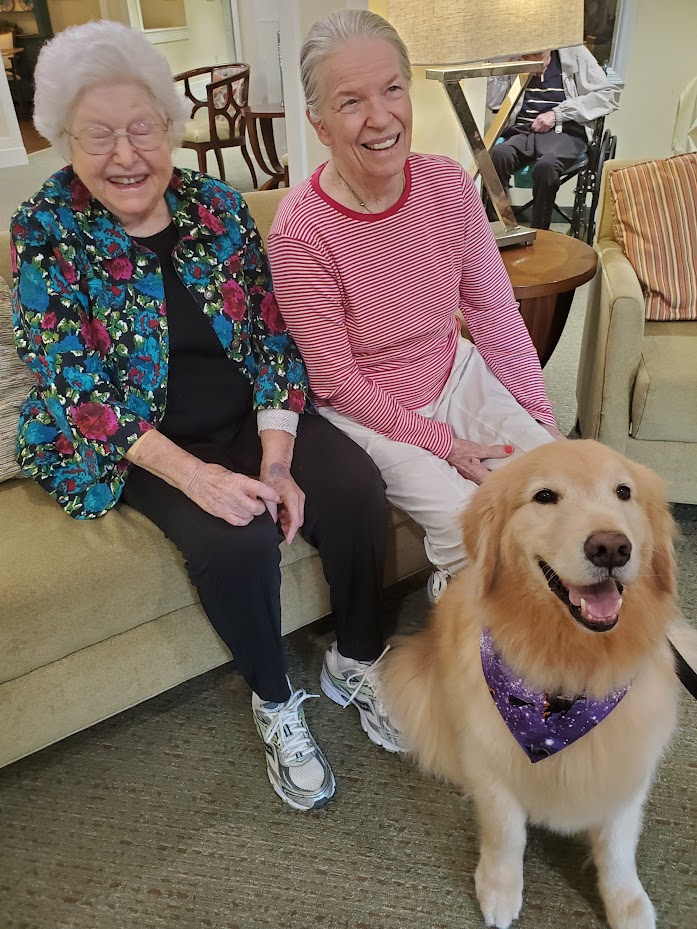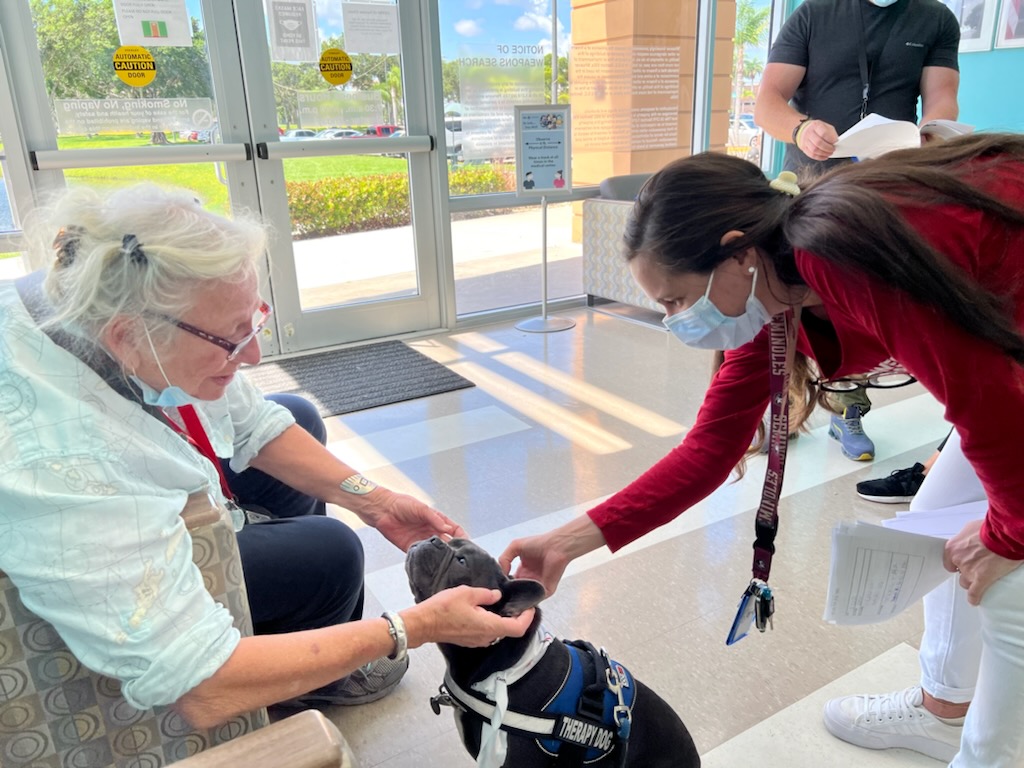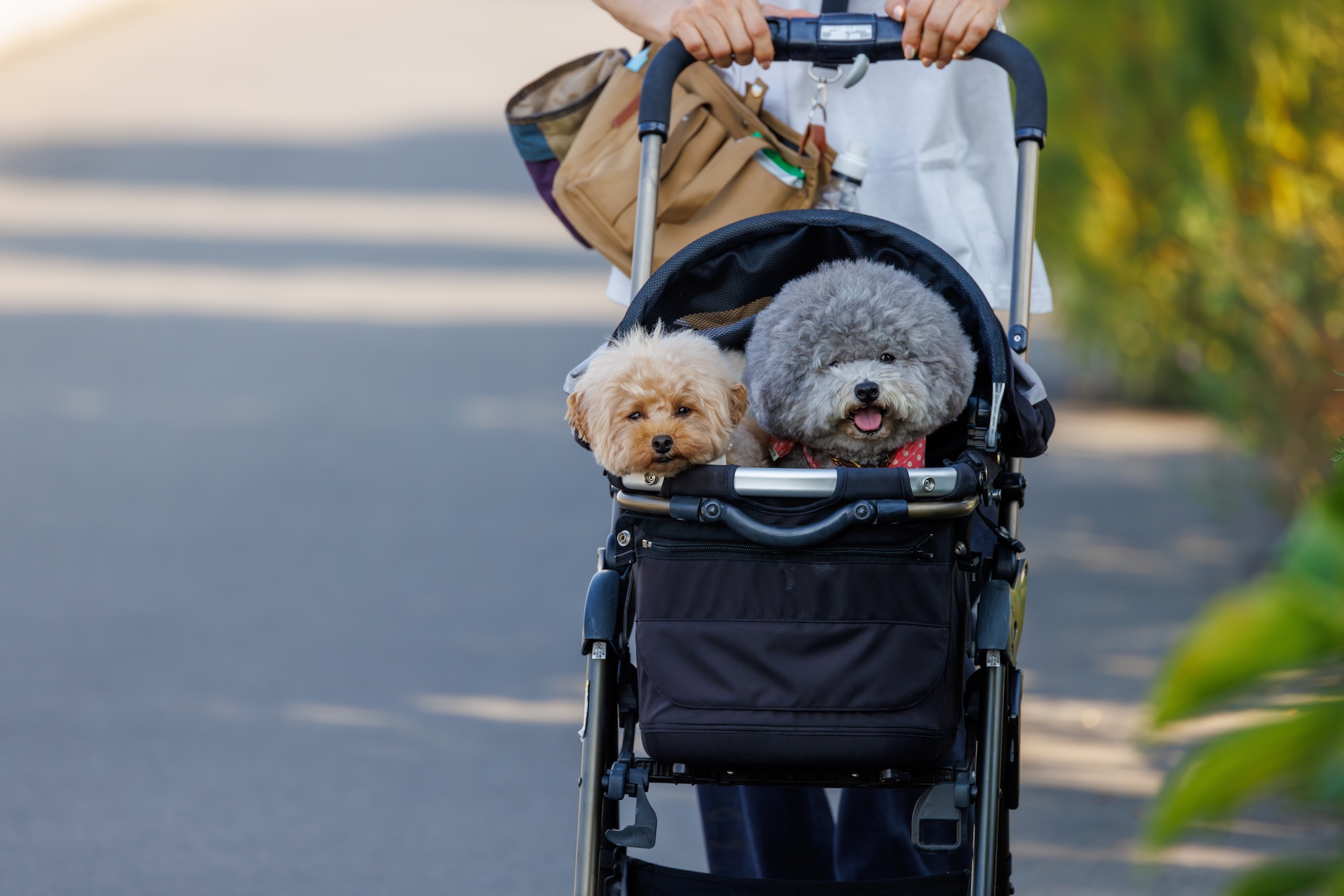We at The Farmer’s Dog are big fans of therapy dogs, who provide emotional support in settings like hospitals, schools, and nursing homes. That’s why we are excited to work with Certified Therapy Dog, Inc., which trains humans and their dogs to become effective therapy teams.
When we spoke with the organization’s founder, Alan Levine, we were struck by how much of their training guidance applies to pretty much any human-dog relationship. While not all dogs are suited to work with new people in challenging environments—Levine says that “90% of a good therapy dog shows up the first day of class,” meaning that training refines the approach of a dog and handler, but doesn’t change a dog’s fundamental disposition toward working with large numbers of people in settings that demand a certain demeanor—every dog can benefit from kindness and communication, and every human with a dog should be mindful of how they interact with the world around them.
In that spirit, here are some takeaways from our recent talk with Levine that can help you whether or not you and your dog ever become a therapy team.
Talking to your dog all day is a smart move
Levine says that one of the first things he tells his students is: “I no longer want you to treat your dog as a dog. I want you to treat your dog as a 2- or 3-year-old child that came out of their room dressed funny.” To him, this means talking to the dog all the time. He says that a dog who receives this communication will be more inclined to stay “by your side, engaged with you, [looking] to you for what it should be doing next.”
This pays dividends for therapy teams, and it’s also a wise policy for anyone with a dog. Your dog can understand more than you might think. While there’s some debate about the extent of dogs’ language comprehension, it’s a good bet that your dog will pick up a lot of what you’re saying. Behaviorist Dr. Ian Dunbar talked to us about how much dogs can follow when addressed in complete sentences; Chaser is one dog who built up a massive vocabulary; and, in general, a stronger bond between human and dog is likely to yield better behavior and more happiness in both parties.
Your dog has interests
Some dogs love being part of therapy teams, and others don’t. But it’s almost certain that there is some way you can harness your dog’s natural talents and inclinations to make their lives more fun.
When we asked experts how to make dogs happy, one point many of them emphasized was that dogs are intelligent creatures who can get bored. Almost any dog will enjoy sniffy walks; many will like working for their food through activities like food puzzles, as long as it’s their choice; some may thrive in agility. Oftentimes, a dog who isn’t given a constructive job will find one of their own; you may not like it if yours barks loudly as a self-appointed guard dog or rips up your furniture when left alone for too long.
There is a tremendous range of activities available to enrich dogs’ lives; if yours seems not to be getting the stimulation they need, it makes sense to experiment with various jobs until you find one that suits them. Watch their body language and make sure they’re having a good time—you’re doing this for them.

Your dog needs an advocate
Speaking of body language: “One of the things we insist upon,” Levine says, “is that if your dog shows any type of distress via any specific kind of indicator, simply remove the dog—be very respectful and courteous and say ‘I’m sorry, but we have to go now.’” Humans aren’t the only ones who can become overwhelmed by meeting a lot of new people or feeling the stress of an emotional situation—dogs can find it hard to handle, too.
Knowing when a dog is enjoying their work, and when they need a break, requires reading the signals they’re sending you through body language and behavior. Any human with a dog should learn the usual signs of fear, aggression, and stress, and also take note of what behavior is normal for their own dog. If yours is getting upset, be kind to them and let them recover. They may need to rest, spend some time on their own, or otherwise recharge.
Socialization is a must
Before the dogs who work with Certified Therapy Dog, Inc. go out to do their jobs in the field, they’re acclimated to the types of stimuli they’ll encounter there. “We expose them to a lot of the equipment they’re going to [see] in the hospitals and the assisted living facilities,” says Levine. “We put them in front of children.” This reflects a training approach that can benefit any dog.
Socializing a puppy can set them up for a happier existence. Whatever they’re going to face in the world—children, cats, vacuum cleaners, trips on the subway—find ways to introduce them to those things, and make their early experiences positive.
Preparation is key
Because therapy dogs may be around vulnerable people, dangerous equipment, and other beings and items that could be hazardous to them or others, Levine says that his program aims to build “situational awareness and preemption” among handlers. He says that dogs who won’t reliably follow a “leave it” command, for example, cannot pass Certified Therapy Dog’s program.
And, no matter how your dog spends their days, “leave it” is one of the basic commands they should know for their own safety and that of those around them. “Drop it” is, too, in case they pick up something they shouldn’t—and, whether your dog roams freely off leash or not, reliable recall could save their life.
In addition to training dogs in skills like the above, Levine educates human participants in canine first aid—including the Heimlich maneuver and CPR. It’s ideal to have a plan in advance for what to do if your dog faces a medical episode, what supplies you might need to treat them, and where you can find an emergency vet if you need one.
Everyone has a different relationship with dogs
If you’re like us, you are happy to see a dog pretty much anywhere you go, no matter when they show up. But not everyone thinks dogs belong everywhere. Levine is aware of the common confusion about the definitions of therapy dogs, service dogs, and emotional support dogs—what they do and where they’re permitted—and of people who mislead others as to the purpose of their own dogs. He turns away anyone who he thinks is aiming for a certification that will simply allow them to tote their dog along wherever they go (and therapy dogs are not, like service dogs are, allowed to go almost anywhere with their handlers regardless of the usual rules).

Levine’s organization also acknowledges the physical vulnerabilities some others may have to dogs’ claws and teeth even if a dog is being gentle, and the possibility that some children may not know how to approach a dog—while on the job, their therapy dogs must have all four paws on the floor; be in the arms of a handler; or, rarely, be in a stroller. For dogs’ and humans’ safety, patients and others who the therapy dogs visit may never pick them up or hold them.
The specifics may vary depending on where your dog goes and what they do, but in general, regardless of your own feelings about these behaviors, you’re likely to encounter others who don’t want your dog running up to them off-leash, jumping on them, or pawing at them. Perhaps they’re afraid of dogs or have an injury or medical condition that makes such interactions dangerous for them. No matter what, training your dog to follow your instructions in such situations will be an asset as you both strive to be exemplary citizens.
This also goes for matters like always picking up your dog’s poop and never falsely claiming that, for example, an ESA is a service dog. Such a deception is not merely a little white lie, and can make life more difficult for people who need service dogs to navigate the world. Showing consideration for those around you will feel good, and in doing so you’ll contribute to more positive feelings about dogs and their humans among the rest of the population.




